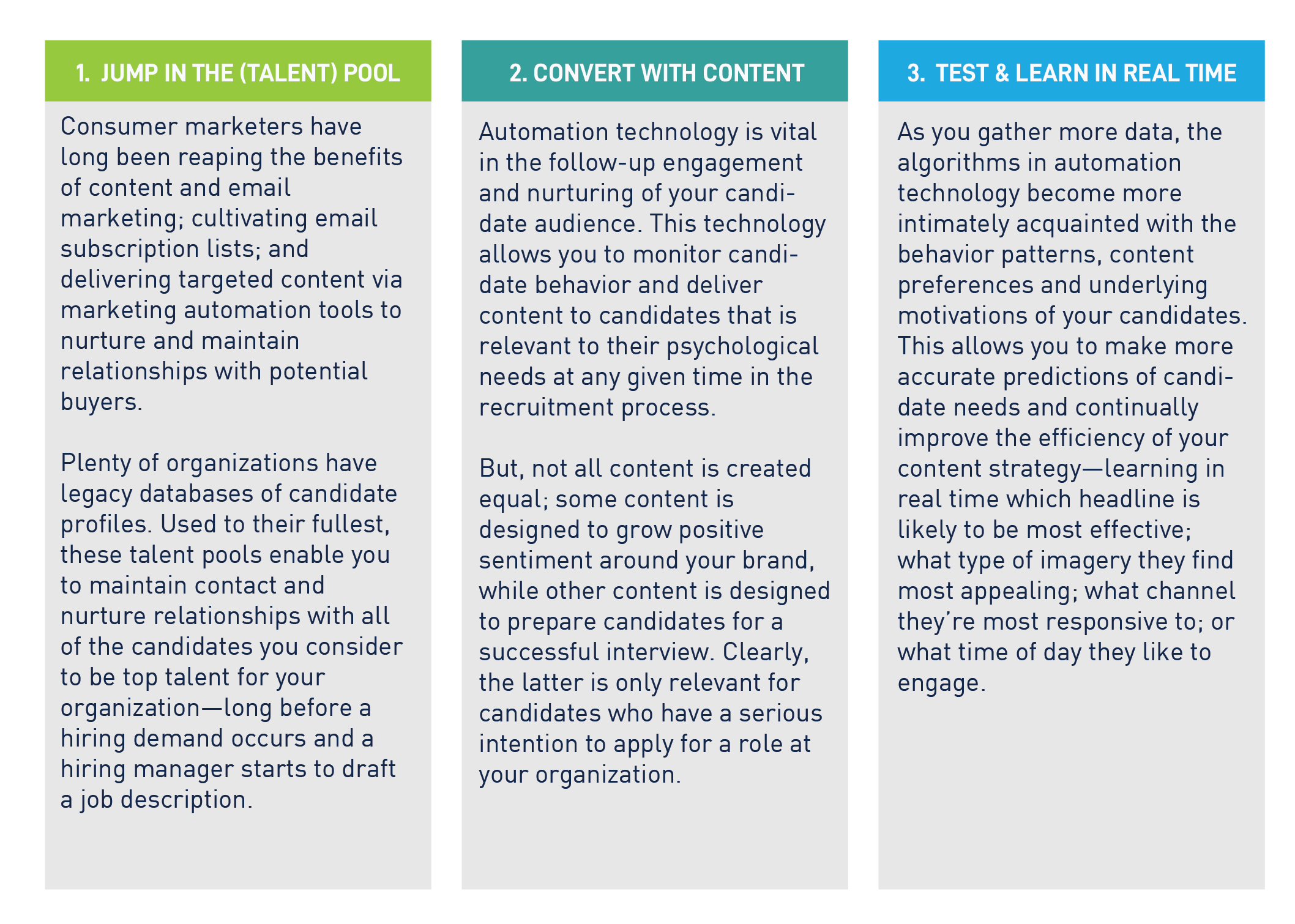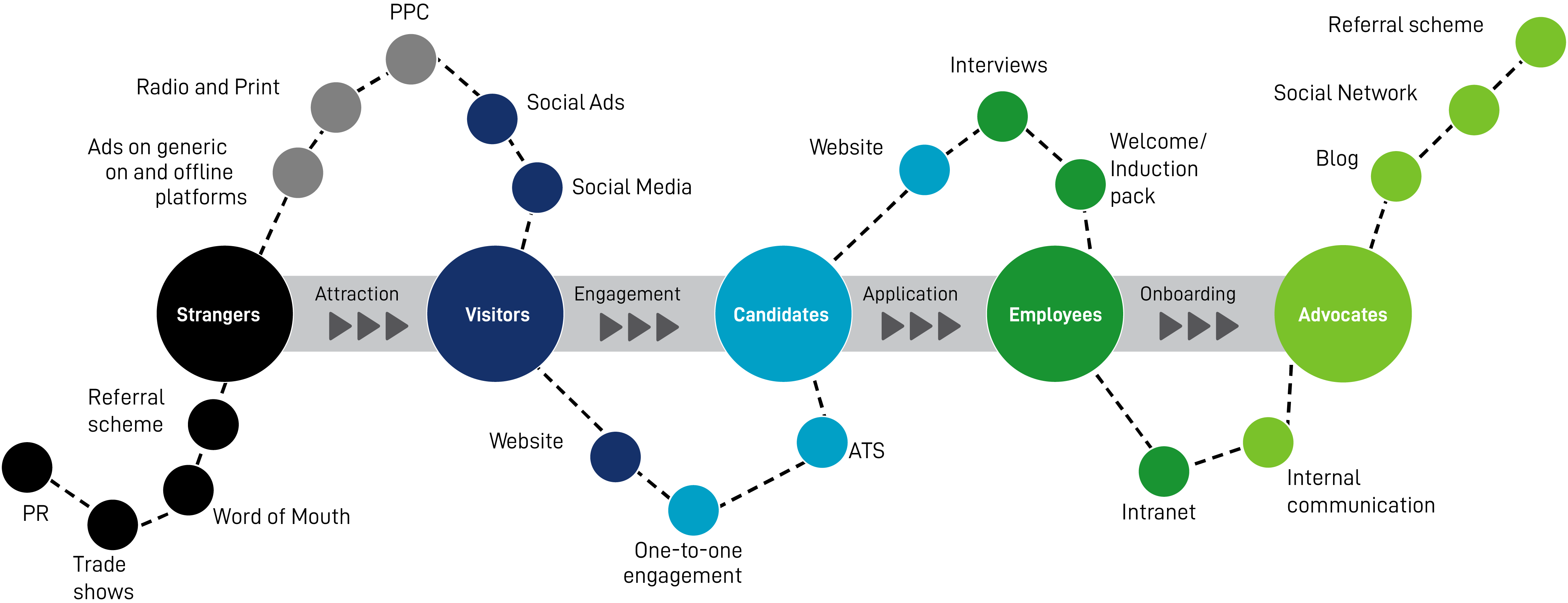Talent attraction means grabbing a candidate’s attention and in this day and age that is not an easy task. Every day, we’re bombarded with between 4,000 and 10,000 ads. Naturally, we don’t give every one of them our full attention; our brains screen out the majority that they consider irrelevant, so we don’t get overwhelmed. Recruitment messages—designed to grow awareness and excitement around job opportunities—are just one subset of ads fighting for our attention in this intense daily contest.
In such a ruthless environment, talent attraction techniques have evolved and adapted. Modern recruitment marketing now draws heavily on consumer marketing practices and technology to ensure that recruiting organisations create clear space between themselves and their competitors. This optimises the likelihood that their messages will receive the attention of the right candidates and fuel growth in healthy pipelines for future vacancies.
This article will walk you through four strategic pillars to succeed in this hugely competitive space for top talent.
Talent Attraction Pillar One: Establishing Your Brand Narrative as a North Star
To attract top talent, you need to tell a vivid story about your unique employer value proposition, or EVP. This proposition should clearly communicate the compelling elements of your employment offer, as well as the behaviors and values you expect of candidates in return.
This narrative allows candidates to make an informed decision about whether your organisation is somewhere they aspire to work and somewhere they can have an influence. But, it also ensures that the people who do go on to apply are in tune with your company values; are motivated to be a part of your team’s mission; and are ready to take on the particular challenges associated with their role.
Recruitment marketing is the task of telling that story—why talent should want to work for you. Specifically, it’s about telling it:
- To the right people, at the right time
- Consistently, with targeted content and experiences that develop a candidate’s understanding of—and trust in—your company
- In exciting and unexpected ways to stand out from the competition
Changing jobs is a significant life event fueled by a complex and highly emotional decision-making process. More than ever, candidates are searching for an employer that exhibits a shared set of values and work that they find meaningful. This is even more apparent in the Millennial and Gen Z members of the workforce. As such, a well-articulated employee value proposition can provoke an emotive response from candidates; give them a first glimpse into your company culture; and differentiate you from your competitors for talent. Without a clearly defined employer brand story, the guiding North Star of your strategy is missing.
Talent Attraction Pillar Two: Build Authenticity & Trust with Your Employees’ Voice
When considering whether to apply for a role, candidates will evaluate the authenticity of your brand claims and develop perceptions of what it’s really like to work for you. Therefore, when it comes to the credibility of your messages, the sources that deliver them are all important. Appetite for glossy corporate advertising is low; candidates are looking for trusted spokespeople to reveal the real story.
- According to Edelman’s brand trust report, nearly seven in 10 people globally use one or more advertising avoidance strategy.
- Personal experience, earned media, and peer-to-peer conversations are far more influential than owned media and paid advertising in the battle for brand trust.
- Industry experts and regular employees are seen as significantly more credible spokespeople for a brand than the company’s CEO.
Similarly, candidates are savvy to corporate clichés and empty promises. Alternatively, they will use resources like Glassdoor and Indeed to seek out the opinions of existing employees who have previously road-tested an employee experience.
Of course, you can’t control everything that’s written about your brand online, but you can empower your most engaged employees to be the voice of your brand by sharing their own experiences. Plus, personal stories will provide you with credible evidence to support your employer value proposition and build credibility amongst your external brand audiences. It can be easy to overcomplicate advocacy; the key is to make it a fun and celebratory process. For instance:
- Make sharing simple. There are many content amplification tools that will allow employees to access your employer brand content and repost it to their own social channels in seconds.
- Introduce a little competition. Award points to employees for sharing their own stories and reposting those of their colleagues.
- Make advocacy rewarding. What do your advocates get in return for being active brand ambassadors? Social media training? Networking opportunities?
But, don’t just expect employees to go off and create great content; you’ll need to offer support. So, consider setting content creation challenges with detailed guidelines to keep them energised and engaged.
Talent Attraction Pillar Three: Connect to Talent with Data-Driven Insights
Top talent doesn’t need to actively look for new opportunities because, like in the consumer world, offers have already started coming to them. Nowadays, passive and active candidate status is no longer clear cut. Whilst some people are actively looking for jobs, it would be incorrect to label everyone else passive and disinterested in new opportunities.
In fact, candidates expect to be approached with new opportunities. A whopping 70% of candidates are passive—open to new opportunities but not actively seeking them out. In such a competitive market, you need to engage your future workforce before the demand to hire them exists.
So, instead of playing the numbers game and hoping that the right person is out there somewhere, wouldn’t it be better to have an existing relationship with the people we think would be perfect for the job? And, better still, to know exactly their level of interest in new opportunities so that, when we do approach them, we know it’s a welcome advance? Fortunately, this is all made possible if we build high-quality, data-driven talent pipelines that provide recruiters with live insights into candidate interest levels and improve their efficiency. Below are three steps you can take to start building talent pipelines.

Pillar Four: Differentiate Your Brand Through Human Experiences
Let’s reimagine the marketing funnel as the journey of a single candidate. Armed with your compelling employer value proposition, the task throughout this journey is to bring the promises of that proposition to life for candidates and reinforce your brand messages so that they build a preference for your organisation.
In other words, rather than just telling candidates why you should be their preferred choice of employer, show them at every touchpoint.

Remember when we referred to your employer brand as your North Star? This is exactly what we meant by that: Use your employer brand and value proposition as a guiding force when crafting all of your recruitment communications and experiences. The more consistently and distinctively your value proposition is expressed throughout the candidate journey (and beyond into the employee lifecycle), the more your brand reputation will align to the identity that you want to portray.
As an example, if you claim to be an employer that cares about employee wellbeing, show candidates from the start by supporting them through the recruitment process with deep empathy. Likewise, if you claim to be an employer that fosters innovation, ensure that your communications are fresh and different.
The way that candidates experience your organisation throughout the candidate journey will show them everything they need to know about how your company treats customers and colleagues. That perception, once created, is hard to shift. If you treat candidates with dignity and show them how their time is valued, most will walk away from the recruitment process feeling positive about the brand you represent—whether they were successful or not. This means that you’re more likely to be the beneficiary of positive word-of-mouth advertising from that individual, as well as ensure that they’re more likely to reengage with you in the future should another, more appropriate, opportunity arise. That could be next week, next month or next year. The long game matters. A human-centric approach is different and will certainly stand out amongst the numerous companies that still facilitate an impersonal hiring process.
Making The Right Match
When these four strategic pillars work cohesively together, they allow you to seek out top talent and start conversations with potential employees wherever they prefer to consume content. Then, you can convert candidates to the next stage of the recruitment process by delivering content that responds to behavioural triggers and underlying candidate motivations. Finally, you can differentiate your organisation from your competitors with human experiences that bring your employer brand to life in unexpected and exciting ways.



